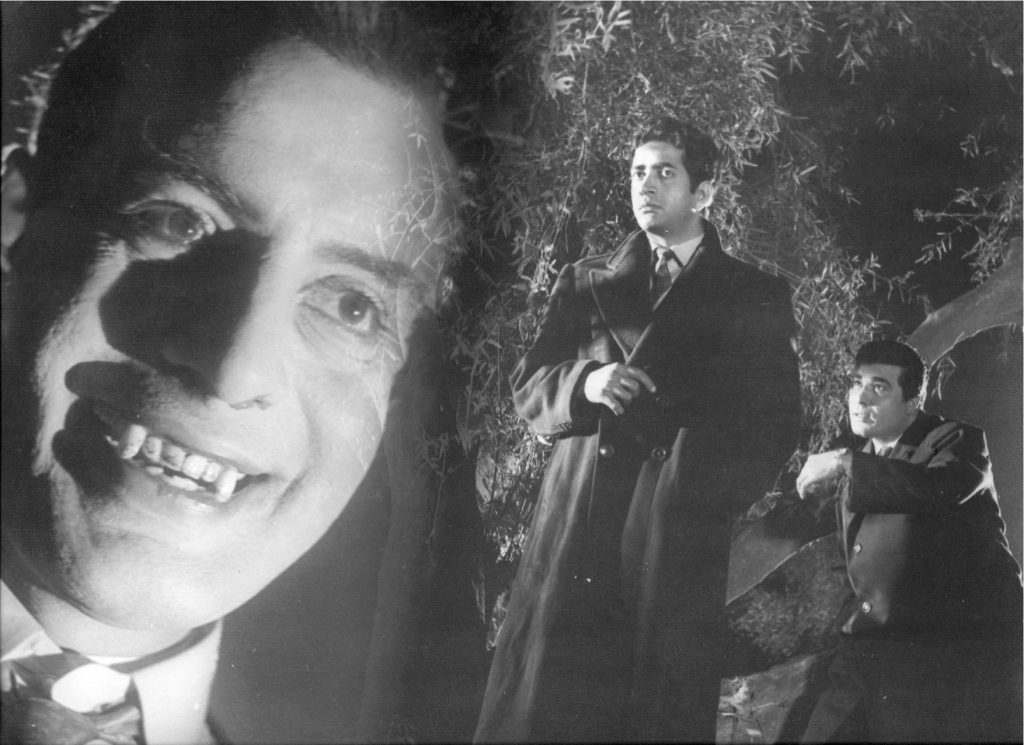Mad scientist Tabani (Rehan) works in his laboratory at home to successfully create an ‘elixir of life’ that will make him immortal. He drinks the potion but things go horribly wrong and he appears to die from its after-effects. As per his specific though somewhat odd request, his mortal remains are confined to a coffin in the cellar of the house. At night however, he rises again, having now become a vampire, who is, of course, thirsty for blood…
It was the first ever Adults only certified film to come out of Pakistan. Not only that, the Pakistani Censor Board clamped down on some of the dance numbers, utterly horrified at the suggestive breast movements of some of the female dancers, which they thought was pure filth. Thankfully however, Zinda Laash not only managed to get past these hurdles and become a huge hit at the box-office – the A certificate bringing in excited audiences in droves – but has since then also gone on to become a cult classic. Not just as a fine horror film in its own right but also as one of the best ever films to come out of Pakistan.
In terms of filmmaking, the praise is more than justified. While almost all Pakistani films down the years suffer from some terribly tacky filmmaking and loud stagey acting, Zinda Laash easily comes across as one of the few well-made films that I have seen from across the border. The narrative flow keeps one reasonably engaged by and large while highly effective use of chiaroscuro by its cinematographers Raza Mir, Nabi Ahmed and Irshad complemented with a suitably moody background score ensure the film’s suitably eerie disposition. What’s interesting is that unlike other films of Lollywood which are anything but subtle, the film actually believes in that key adage of filmmaking – that less is more. Even as Zinda Laash evokes a menacing-for-its-time atmosphere by playing around with some highly provocative and symbolic visuals, cobwebs and other well-known horror props, it mostly keeps its blood and gore out of the frame. This coupled with the low-key expressionist lighting scheme makes for far more rewarding viewing, as the violence is mostly left to the viewer’s imagination instead of playing out in front of him in a rather obvious manner. Perhaps it also helped that the reference point for the film was the well-known Hammer production, House Of Dracula (1958), with the iconic Christopher Lee as Count Dracula.
Ironically, Zinda Laash was not even a film director Khwaja Sarfraz wanted to make. He was certain that the Pakistani audience was not ready for anything like this and that a film of this type had no chance at the box-office. However, he was stuck as Habib, actor-producer of the film and technically its lead man – since Dracula/Tabani is the ‘villain’ – was a close friend and even as he was dragging out his reluctance to say yes to the film, Sarfraz was finding to difficult to say no to him. Finally he laid out certain parameters – the right to select the cinematographer and the background music composer besides the choice of sets and locations which would be key to the story. A delighted Habib readily agreed to all his terms and the film was on.
While one has no issues with the film’s technicalities, Zinda Laash does have a rather dated feel in several places and also some serious script issues. While the sequences within Tabani’s house are riveting say the least , the film fails to engage as nicely when outside this key location. And for all its supposed modernity with sequences set inside Pakistani nightclubs, it appears rather conservative in its treatment of the white v/s black elements of the story. The songs too appear out of nowhere and hinder rather then aid the plot, doing little for the film’s narrative. The two club songs, though, do have some surprisingly aesthetic and sensual choreography in them that unsurprisingly invited the censor’s wrath. But one place where Zinda Laash does slip in a bit of an eye-opening surprise is in its treatment of the women who become Tabani’s victims. They revel in discovering their sexuality as Tabani ‘bites’ them. They subsequently have nothing to do with typical domestic life after his ‘visits’ and, in fact, wait for them eagerly.
In terms of performances, Rehan, with fangs specially imported from abroad, was the unanimous choice for Tabani’s role for both Habib and Sarfraz. He is absolutely perfect as the caped prince of darkness and dominates the film even as he makes the role his own. Of the rest, Habib is fine enough in support while Nasreen is particularly noteworthy as Rehan’s first victim once he becomes a vampire.
Following it’s success at the time of its release, Zinda Laash‘s print was thought to be lost forever. However, thanks to the persevering efforts of Pakistani filmmaker Omar Ali Khan – also perhaps the film’s greatest admirer – the film’s negatives, thought to have been washed away in the floods of 1996, were discovered in rusty cans at Evernew Studios in Pakistan. Khan worked on getting the film restored and oversaw the release of a good quality DVD of the film thanks to which it enjoys a renewed interest among current audiences and continues to build on its formidable reputation even today.
Urdu, Horror, Drama, Black & White
Header picture courtesy Omar Ali Khan


